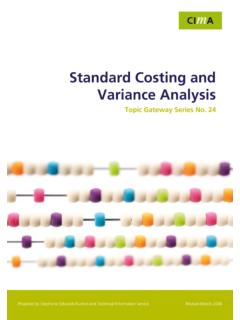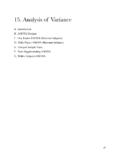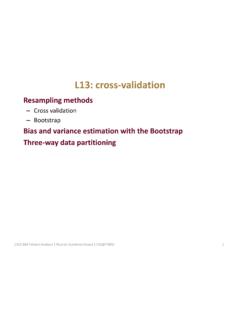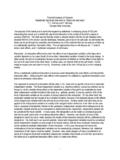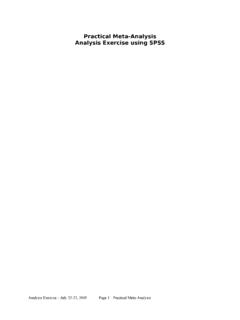Transcription of One-Way Analysis of Variance (ANOVA) Example Problem ...
1 One-Way Analysis of Variance ( anova ) Example Problem Introduction Analysis of Variance ( anova ) is a hypothesis-testing technique used to test the equality of two or more population (or treatment) means by examining the variances of samples that are taken. anova allows one to determine whether the differences between the samples are simply due to random error (sampling errors) or whether there are systematic treatment effects that causes the mean in one group to differ from the mean in another. Most of the time anova is used to compare the equality of three or more means, however when the means from two samples are compared using anova it is equivalent to using a t-test to compare the means of independent samples.
2 anova is based on comparing the Variance (or variation) between the data samples to variation within each particular sample. If the between variation is much larger than the within variation, the means of different samples will not be equal. If the between and within variations are approximately the same size, then there will be no significant difference between sample means. Assumptions of anova : (i) All populations involved follow a normal distribution. (ii) All populations have the same Variance (or standard deviation). (iii) The samples are randomly selected and independent of one another.
3 Since anova assumes the populations involved follow a normal distribution, anova falls into a category of hypothesis tests known as parametric tests. If the populations involved did not follow a normal distribution, an anova test could not be used to examine the equality of the sample means. Instead, one would have to use a non-parametric test (or distribution-free test), which is a more general form of hypothesis testing that does not rely on distributional assumptions. Example Consider this Example : Suppose the National Transportation Safety Board (NTSB) wants to examine the safety of compact cars, midsize cars, and full-size cars.
4 It collects a sample of three for each of the treatments (cars types). Using the hypothetical data provided below, test whether the mean pressure applied to the driver s head during a crash test is equal for each types of car. Use = 5%. Table Compact cars Midsize cars Full-size cars 643 469 484 655 427 456 702 525 402 X S (1.)
5 State the null and alternative hypotheses The null hypothesis for an anova always assumes the population means are equal. Hence, we may write the null hypothesis as: H0: 321 == - The mean head pressure is statistically equal across the three types of cars. Since the null hypothesis assumes all the means are equal, we could reject the null hypothesis if only mean is not equal. Thus, the alternative hypothesis is: Ha: At least one mean pressure is not statistically equal. (2.) Calculate the appropriate test statistic The test statistic in anova is the ratio of the between and within variation in the data.
6 It follows an F distribution. Total Sum of Squares the total variation in the data. It is the sum of the between and within variation. Total Sum of Squares (SST) = == ricjijXX112)(, where r is the number of rows in the table, c is the number of columns, X is the grand mean, and ijX is the ith observation in the jth column. Using the data in Table we may find the grand mean: )402456484525427469702655643(=++++++++== NXXij SST = ) (..) () () () (22222= ++ + + + Between Sum of Squares (or Treatment Sum of Squares) variation in the data between the different samples (or treatments).
7 Treatment Sum of Squares (SSTR) = 2)(XXrjj, where jr is the number of rows in the jth treatment and jX is the mean of the jth treatment. Using the data in Table , SSTR = ]) (3[]) (3[]) (3[222= + + Within variation (or Error Sum of Squares) variation in the data from each individual treatment. Error Sum of Squares (SSE) = 2)(jijXX From Table , SSE=+ + + ]) () () [(222 ]) () () [(222 + + + ]) () () [(222 + + = 10254. Note that SST = SSTR + SSE ( = + 10254). Hence, you only need to compute any two of three sources of variation to conduct an anova . Especially for the first few problems you work out, you should calculate all three for practice.
8 The next step in an anova is to compute the average sources of variation in the data using SST, SSTR, and SSE. Total Mean Squares (MST) 1 =NSST average total variation in the data (N is the total number of observations) MST = )19( Mean Square Treatment (MSTR) = 1 cSSTR average between variation (c is the number of columns in the data table) MSTR = )13( Mean Square Error (MSE) = cNSSE average within variation MSE = 1709)39(10254= Note: MST MSTR + MSE The test statistic may now be calculated. For a One-Way anova the test statistic is equal to the ratio of MSTR and MSE.
9 This is the ratio of the average between variation to the average within variation. In addition, this ratio is known to follow an F distribution. Hence, F = The intuition here is relatively straightforward. If the average between variation rises relative to the average within variation, the F statistic will rise and so will our chance of rejecting the null hypothesis. (3.) Obtain the Critical Value To find the critical value from an F distribution you must know the numerator (MSTR) and denominator (MSE) degrees of freedom, along with the significance level. FCV has df1 and df2 degrees of freedom, where df1 is the numerator degrees of freedom equal to c-1 and df2 is the denominator degrees of freedom equal to N-c.
10 In our Example , df1 = 3 - 1 = 2 and df2 = 9 - 3 = 6. Hence we need to find CVF6,2corresponding to = 5%. Using the F tables in your text we determine that CVF6,2= (4.) Decision Rule You reject the null hypothesis if: F (observed value) > FCV (critical value). In our Example > , so we reject the null hypothesis. (5.) Interpretation Since we rejected the null hypothesis, we are 95% confident (1- ) that the mean head pressure is not statistically equal for compact, midsize, and full size cars. However, since only one mean must be different to reject the null, we do not yet know which mean(s) is/are different.

